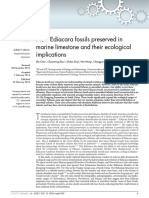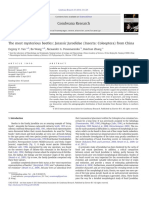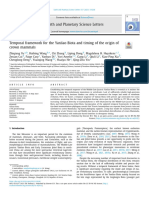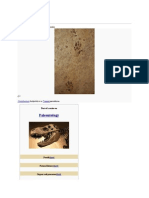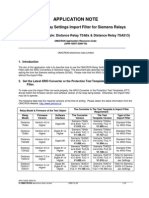Oldest Coelacanth, From The Early Devonian of Australia: References Email Alerting Service
Oldest Coelacanth, From The Early Devonian of Australia: References Email Alerting Service
Uploaded by
paleozoicfishCopyright:
Available Formats
Oldest Coelacanth, From The Early Devonian of Australia: References Email Alerting Service
Oldest Coelacanth, From The Early Devonian of Australia: References Email Alerting Service
Uploaded by
paleozoicfishOriginal Title
Copyright
Available Formats
Share this document
Did you find this document useful?
Is this content inappropriate?
Copyright:
Available Formats
Oldest Coelacanth, From The Early Devonian of Australia: References Email Alerting Service
Oldest Coelacanth, From The Early Devonian of Australia: References Email Alerting Service
Uploaded by
paleozoicfishCopyright:
Available Formats
Downloaded from rsbl.royalsocietypublishing.
org on 18 November 2009
Oldest coelacanth, from the Early Devonian of Australia
Zerina Johanson, John A Long, John A Talent, Philippe Janvier and James W Warren Biol. Lett. 2006 2, 443-446 doi: 10.1098/rsbl.2006.0470
References Email alerting service
This article cites 18 articles, 1 of which can be accessed free
http://rsbl.royalsocietypublishing.org/content/2/3/443.full.html#ref-list-1
Receive free email alerts when new articles cite this article - sign up in the box at the top right-hand corner of the article or click here
To subscribe to Biol. Lett. go to: http://rsbl.royalsocietypublishing.org/subscriptions
This journal is 2006 The Royal Society
Downloaded from rsbl.royalsocietypublishing.org on 18 November 2009
Biol. Lett. (2006) 2, 443446 doi:10.1098/rsbl.2006.0470 Published online 21 March 2006
Oldest coelacanth, from the Early Devonian of Australia
Zerina Johanson1,2,*, John A. Long3, John A. Talent2, Philippe Janvier4 and James W. Warren5
1 Department of Biological Sciences, and 2MUCEP Department of Earth , and Planetary Sciences, Macquarie University, Sydney, New South Wales 2109, Australia 3 Museum Victoria, PO Box 666E, Melbourne, Victoria 3000, Australia 4 UMR 5143 CNRS, Museum National dHistoire Naturelle, 8 rue Buffon, Paris 75005, France 5 Monash University, Clayton, Victoria 3168, Australia *Author for correspondence (zjohanso@bio.mq.edu.au).
closer to the estimated timing of divergence of the Sarcopterygii. This new dentary possesses a dentary sensory pore, which is otherwise a derived character among coelacanths (Forey 1998). Either a dentary sensory pore arose twice during coelacanth evolution (supported by the stratigraphic position of this material) or this new early coelacanth belongs to a more crownward taxon within the group, suggesting that the origins of the actinistian clade may be even older. The third possibility is that the dentary sensory pore is a primitive character, with the absence of the pore a derived character among Devonian taxa. However, following the most recent coelacanth phylogeny (Forey 1998), the presence of a dentary sensory pore would need to be re-acquired in Carboniferous and later taxa (three evolutionary steps versus two). 2. MATERIAL AND METHODS
Specimens were recovered by acetic acid preparation of large rock samples and manual picking through the resulting residues. Scanning electron microscopy utilized a LEO 435 VP, with drawings made directly from these images.
Coelacanths are well-known sarcopterygian (lobe-nned) shes, which together with lungshes are the closest extant relatives of land vertebrates (tetrapods). Coelacanths have both living representatives and a rich fossil record, but lack fossils older than the late Middle Devonian (385390 Myr ago), conicting with current phylogenies implying coelacanths diverged from other sarcopterygians in the earliest Devonian (410415 Myr ago). Here, we report the discovery of a new coelacanth from the Early Devonian of Australia (407409 Myr ago), which lls in the approximately 20 Myr ghost range between previous coelacanth records and the predicted origin of the group. This taxon is based on a single lower jaw bone, the dentary, which is deep and short in form and possesses a dentary sensory pore, otherwise seen in Carboniferous and younger taxa. Keywords: Actinistia; Sarcopterygii; Early Devonian; ghost range
1. INTRODUCTION Morphological and molecular sequence data clearly demonstrate that the living coelacanth Latimeria (Actinistia) is the closest relative of lungshes and tetrapods (Cloutier & Ahlberg 1997; Brinkmann et al. 2004). However, the earliest known lungshes and their relatives (Dipnomorpha) are Early Devonian in age (LochkovianPragian, ca 410415 Myr ago), as are the onychodonts, another fossil group of basal sarcopterygians (Chang 1982; Chang & Yu 1984; Zhu et al. 2001; Zhu & Yu 2004). Previously, the earliest known coelacanths, such as Miguashaia, Euporosteus and Gavinia ( Jaekel 1927; Schultze 1973; Cloutier 1996; Long 1999; Forey et al. 2001), were Middle Late Devonian (i.e. 375390 Myr ago) in age, such that coelacanths had an unrecorded ghost range of at least 20 Myr. The recent description of Holopterygius nudus as an aberrant late Middle Devonian coelacanth with eel-like morphology pin-points the beginning of coelcanths radiating into varying niches by this stage (Friedman & Coates 2005). The description below of a new coelacanth dentary from the Early Devonian of Australia (midLate Pragian, ca 407409 Myr ago; Gradstein et al. 2005), reduces this ghost range considerably and brings the coelacanth fossil record
Received 15 February 2006 Accepted 21 February 2006
3. RESULTS (a) Taxonomy We classied our new coelacanth as follows: Osteichthyes Huxley, 1880; Sarcopterygii Romer, 1955; Actinistia Cope, 1871; Eoactinistia gen. nov. Type species. Eoactinistia foreyi sp. nov., midLate Pragian, Fairy Formation, located near the town of Buchan, eastern Victoria, Australia (gure 1). Holotype. NMV (Museum Victoria, Melbourne) 218301, left dentary. Diagnosis. Differs from other actinistians in having a rectangular dentary approximately only twice as long as deep, with distinct groove along the posterior margin, forming complex interlocking overlap with angular. Also, combination of characters in the lower jaw: dentary short, teeth fused to dentary, dentary pore present. Etymology. Eoactinistia, dawn coelacanth, foreyi, for Peter Forey (Natural History Museum, London), for his contributions to coelacanth studies. Description. The dentary of E. foreyi is complete, with unbroken margins anteriorly and posteriorly, except perhaps for the posterodorsal corner (gure 2e, small arrow). The dentary is short, as is characteristic for the Actinistia, being slightly more than twice as long as deep, giving the dentary a squat appearance overall. By comparison, the dentary of other Devonian taxa such as Gavinia, Holopterygius and Miguashaia is narrower and more slender in appearance (Long 1999; Forey et al. 2001; Friedman & Coates 2005; gure 2h). Although it would be preferable to determine the length of the dentary by comparison with other associated bones of the jaw, the undamaged margins and relative proportions of the dentary of Eoactinistia suggest a short, rectangular element. Among other sarcopterygian shes, the dentary is longer, comprising much of the length of the lower jaw, although a shorter dentary also characterizes the Dipnoi (lungsh). However, in lungsh, when teeth occur on the dentary, they often originate and are patterned in a manner similar to those on the prearticular. For example, in lungsh with a tooth-plated dentition, radiating rows of teeth
443
q 2006 The Royal Society
Downloaded from rsbl.royalsocietypublishing.org on 18 November 2009
444
Z. Johanson and others
Oldest coelacanth, from Australia
Cainozoic alluvials Buchan Group Taravale Formation Buchan Caves Limestone (including Spring Creek Member) Jellung Ignimbrite MacRae Ignimbrite Fairy Formation Carson Creek Ignimbrite unnamed intrusive (feldsparhornblende porphyry) dip fault
Carson
Cr ee
h Buc an
Snowy River Volcanics
Riv
Lo us ad
er
30
Gu lly
40
Mitta Mitta R. Victoria Buchan Caves Reserve Omeo Buchan location 200 km 45 50
Melbourne Tambo R.
Sp
rin
g Cr eek
50 65 37 30
Creek
fossil locality
Buchan
N
Fairy
82
32
200
400
600
800 1000 m
Figure 1. Stratigraphic position of the Fairy Formation and location of fossil locality in eastern Victoria, Australia.
are found on both prearticular and dentary (e.g. Chang & Yu 1984; Reisz & Smith 2001). In taxa such as Orlovichthys limnatus and Holodipterus longi, two single rows of teeth are present on the dentary, but are positioned at a 908 angle to one another (Pridmore et al. 1994; Krupina et al. 2001). Both these morphologies are very different from dentary teeth in other sarcopterygians, including coelacanths, which supports the assignment of Eoactinistia to this group. The dentary of Eoactinistia is divided posteriorly by a narrow groove (gure 2af, gr), comparable to the Carboniferous taxon Polyosteorhynchus (Lund & Lund 1985). The ornamentation comprises small, irregularly distributed ridges with small pores in the furrows. Internally the bone is smooth, with a low ridge running dorsoventrally, beginning near the posterior margin of the dentary pore (described below), and ending and dening, the end of the tooth row (gure 2e, f, arrowhead). Up to seven teeth form this tooth row, which are represented by rounded sockets and form a typical sarcopterygian row along the dentary, as in both species of Miguashaia, Gavinia and other basal coelacanth taxa such as Diplocercides
Biol. Lett. (2006)
(Forey 1998; gure 2a,ce, teeth), rather than having teeth on isolated plates, the latter being the derived character state (Forey 1998). In external view, the ventral margin is marked by a shallow indentation (gure 2a,b), matched in internal view by a narrow, scalloped area, distinct from the internal surface of the bone. This scalloped area forms a distinct rim around the indentation (gure 2f,g, p.rim). The combination of these features suggests the presence of a true opening along the dentary margin, which we suggest represents the dentary sensory pore, separating the dentary from the (unpreserved) splenial (gure 2a,b,eg, d.pore). A dentary sensory pore is also absent in lungsh. As noted by Forey (1998), the dentary pore is not homologous to the infradentary foramina characterizing the lower jaws of several members of the Dipnomorpha, as this foramen separates the infradentary bones themselves (e.g. splenial, angular, surangular), whereas in coelacanths, the dentary pore separates the dentary from the splenial. Forey (1998) suggested that the dentary pore was derived within the coelacanths, also supporting identication of Eoactinistia as a coelacanth.
Downloaded from rsbl.royalsocietypublishing.org on 18 November 2009
Oldest coelacanth, from Australia Z. Johanson and others
(a) teeth gr (b) oa.Ang2 (c) teeth gr (d) teeth oa.Ang2
445
oa.Ang1 d.pore (e) teeth (f) gr d.pore (g) p.rim (h)
Ang oa.Ang1 d.pore oa.Ang1 d.pore p.rim d.pore Dent Spl
Figure 2. Eoactinistia foreyi, NMV 218301, dentary in (a, b) lateral, (c, d ) dorsal and (e, f ) medial or internal views, (g) close up view of dentary pore, internal dentary surface, (h) Gavinia syntrips, representing a phylogenetically basal coelacanth (Middle Devonian, Australia), to illustrate the relationship between the dentary (grey) and other bones of the jaw. Note absence of dentary pore (from Long 1999). Scale, 200 mm; Ang, angular bone; d.pore, dentary pore; Dent, dentary bone; gr, narrow groove; oa.Ang1, 2, overlap surfaces for angular; p.rim, rim surrounding dentary pore; Spl, splenial bone; teeth, teeth associated with dentary in marginal tooth row. Larger arrows indicate anterior. ((h) Courtesy of Western Australian museum.)
Posteriorly, the ventral margin of the dentary is strongly inected, presenting a smooth surface and forming a curved contact with the angular bone (gure 2b,e, f, oa.Ang1). Dorsal to this contact with the angular, the narrow groove separates the posterior region of the dentary into dorsal and ventral halves. The dorsal half is slightly depressed relative to the rest of the bone, representing a second overlap area for the angular (gure 2b,d, oa.Ang2). The end of the tooth row marks the beginning of this overlap surface (gure 2a, the end of the tooth row is continued ventrally by some type of overgrowth). Thus, we suggest the angular has a complex interlocking relationship with the dentary, possibly to increase strength of the bite. (b) Geological age and stratigraphic distribution The Fairy Formation (Warren & Talent 1967) has produced a diverse fauna, including plant, invertebrate and vertebrate remains, from a lens 33 m thick. The lens outcrops beneath 310460 m of ignimbrites high in the Snowy River Volcanics. This unit is underlain with angular unconformity by the Cowombat Formation, the uppermost horizons of which are latest Silurian (Pridol; Simpson & Talent 1995). Conodonts from the stratigraphically lowest unit of the overlying Buchan Group, the Buchan Caves Limestone (Talent 1956; Mawson et al. 1992), show that the PragianEmsian ( pireneae Zone-dehiscens Zone) boundary falls approximately halfway up the Buchan Caves Limestone, implying a pre-Emsian age for E. foreyi and associated biota. The youngest age that could be allocated to the Fairy Formation is therefore midLate Pragian pireneae Zone. The thickness of Snowy River Volcanics accumulated prior to the Fairy Formation (thousands of metres versus 310460 m; Orth et al. 1995) rules against the Fairy Formation being much older than midLate Pragian (ca 407409 Myr ago).
Biol. Lett. (2006)
4. DISCUSSION The Late SilurianEarly Devonian (ca 416418 Myr ago; Gradstein et al. 2005) marks the origin of nearly all the known major groups within the osteichthyans (i.e. bony shes, including ray-nned shes, or actinopterygians, and sarcopterygians; Janvier 1996). Within sarcopterygians, taxa assigned to the crowngroup Sarcopterygii, including groups such as the onychodonts (Zhu et al. 2001; Zhu & Yu 2004) and the Dipnomorpha (Chang 1982; Chang & Yu 1984) rst appear, as well as phylogenetically more basal stem-group sarcopterygian taxa such as Psarolepis and Achoania (Zhu & Schultze 1997; Yu 1998; Zhu et al. 2001; Zhu & Yu 2002). Coelacanths (also part of the crown-group Sarcopterygii) such as Miguashaia, Holopterygius, Euporosteus, Gavinia and Diplocercides are all Middle (Givetian) to Late Devonian (Frasnian) in age. The Early Devonian (midLate Pragian) age of E. foreyi provides the rst record of coelacanths prior to the Middle Devonian, and lls a gap of at least 20 Myr between these previously oldest known coelacanths and the nearest sarcopterygian relatives of the group. Interestingly, the dentary pore is absent from all other Devonian taxa, being shared by Eoactinistia and some more crownward coelacanths (g. 9.7, node 6 in Forey 1998) of Carboniferous and younger age. Lack of material precludes a phylogenetic analysis of the Actinistia including Eoactinistia, though the resolution of Eoactinistia as a more crownward taxon would create a new ghost range within the group, extending prior to the Early Devonian and even closer to the origin of the Osteichthyes as a whole. Alternatively, a dentary pore evolved twice in the Actinistia. Either way, Eoactinistia presents new challenges to the interpretation of early coelacanth evolution.
Acid-leaching of limestone nodules was undertaken by K. Simpson, I. R. Stewart and M. J. Engelbretsen. A. H. M. VandenBerg provided maps and data of the Snowy
Downloaded from rsbl.royalsocietypublishing.org on 18 November 2009
446
Z. Johanson and others
Oldest coelacanth, from Australia
Lund, R. L. & Lund, W. L. 1985 Coelacanths from Bear Gulch limestone (Namurian) of Montana and the evolution of Coelacanthiformes. Bull. Carnegie Mus. Nat. Hist. 25, 174. Mawson, R., Talent, J. A., Brock, G. A. & Engelbretsen, M. J. 1992 Conodont data in relation to sequences about the PragianEmsian boundary (Early Devonian) in southeastern Australia. Proc. R. Soc. Victoria 104, 2356. Orth, K., VandenBerg, A. H. M., Nott, R. J. & Simons, B. A. 1995 Murrindal 1 : 100,000 map geological report. Geol. Surv. Victoria Rep. 100, 1235. Pridmore, P. A., Campbell, K. S. W. & Barwick, R. E. 1994 Morphology and phylogenetic position of the holodipteran dipnoans of the Upper Devonian Gogo Formation of northwestern Australia. Phil. Trans. R. Soc. B 344, 105164. Reisz, R. R. & Smith, M. M. 2001 Lungsh dental pattern conserved for 360 Myr. Nature 411, 548. (doi:10.1038/ 35079187) Schultze, H.-P. 1973 Crossopterygier mit heterozerker Schwanzose aus dem Oberdevon Kanadas, Nebst einer Beschreibung von Onychodontida-Resten aus dem Mittledevon Spaniens und dem Karbon der USA. Palaeontographica 143A, 188208. Simpson, A. J. & Talent, J. A. 1995 Silurian conodonts from the headwaters of the Indi (upper Murray) and Buchan rivers, southeastern Australia, and their implications. Cour. Forsch-Inst. Senckenberg 182, 79215. Talent, J. A. 1956 Devonian brachiopods and pelycopods from the Buchan Caves limestone, Victoria. Proc. R. Soc. Victoria 68, 156. Warren, J. W. & Talent, J. A. 1967 Devonian sh from Buchan, Victoria. Aust. NZ Assoc. Adv. Sci., Abstr., Sect., C, K1. Yu, X.-B. 1998 A new porolepiform-like sh, Psarolepis romeri, gen. et sp. nov. (Sarcopterygii, Osteichthyes) from the Lower Devonian of Yunnan, China. J. Vert. Paleo. 18, 261274. Zhu, M. & Schultze, H.-P. 1997 The oldest sarcopterygian sh. Lethaia 30, 293304. Zhu, M. & Yu, X.-B. 2002 A primitive sh close to the common ancestor of tetrapods and lungsh. Nature 418, 767770. (doi:10.1038/nature00871) Zhu, M. & Yu, X.-B. 2004 Lower jaw character transitions among major sarcopterygian groupsa survey based on new material from Yunnan, China. In Recent advances in the origin and early radiation of vertebrates (ed. G. Arratia, M. V. H. Wilson & R. Cloutier), pp. 271286. Munchen: Dr. Friedrich Pfeil. Zhu, M., Yu, X.-B. & Ahlberg, P. E. 2001 A primitive sarcopterygian sh with an eyestalk. Nature 410, 8184. (doi:10.1038/35065078)
River Volcanics. Z.J. thanks the Museum National dHistoire Naturelle for a visiting fellowship in 2004, where part of this work was completed.
Brinkmann, H., Venkatesh, B., Brenner, S. & Meyer, A. 2004 Nuclear protein-coding genes support lungsh and not the coelacanth as the closest living relatives of land vertebrates. Proc. Natl Acad. Sci. USA 101, 49004905. (doi:10.1073/pnas.0400609101) Chang, M.-M. 1982 The braincase of Youngolepis, a Lower Devonian crossopterygian from Yunnan, south-eastern China. Ph.D. thesis, Stockholm: University of Uppsala. Chang, M.-M. & Yu, X.-B. 1984 Structure and phylogenetic signicance of Diabolichthys speratus gen. et sp. nov., a new dipnoan-like form from the Lower Devonian of eastern Yunnan, China. Proc. Linn. Soc. NSW 107, 171184. Cloutier, R. 1996 The primitive actinistian Miguashaia bureaui Schultze (Sarcopterygii). In Devonian shes and plants of Miguasha, Quebec, Canada (ed. H.-P. Schultze & R. Cloutier), pp. 227247. Munchen: Dr. Friedrich Pel. Cloutier, R. & Ahlberg, P. E. 1997 Morphology, characters, and the interrelationships of basal sarcopterygians. In Interrelationship of shes (ed. L. J. Stiassny, L. R. Parenti & G. D. Johnson), pp. 445479. San Diego, CA: Academic Press. Forey, P. L. 1998 History of coelacanth shes. London: Chapman & Hall. Forey, P. L., Ahlberg, P. E., Luksevics, E. & Zupins, I. 2001 A new coelacanth from the Middle Devonian of Latvia. J. Vert. Paleo. 20, 243252. Friedman, M. & Coates, M. I. 2005 A newly recognised fossil coelacanth highlights the early morphological diversication of the clade. Proc. R. Soc. B 273, 245250. Gradstein, F. M., Ogg, J. & Smith, A. 2005 A geologic time scale 2004. Cambridge, UK: Cambridge University Press. Jaekel, O. 1927 Der Kopf der Wirbeltiere. Ergeb. Anat. Entwicklung. 27, 815827. Janvier, P. 1996 Early vertebrates. Oxford: Oxford Science Publications. Krupina, N. I., Reisz, R. R. & Scott, D. 2001 The skull and tooth system of Orlovichthys limnatis, a Late Devonian dipnoan from Russia. Can. J. Earth Sci. 38, 13011311. (doi:10.1139/cjes-38-9-1301) Long, J. A. 1999 A new genus of fossil coelacanth (Osteichthyes: Coelacanthiformes) from the Middle Devonian of southeastern Australia. Rec. West. Aust. Mus. Suppl. 57, 3754.
Biol. Lett. (2006)
You might also like
- Pelvic Girdle and Fin of Tiktaalik Roseae PDFDocument7 pagesPelvic Girdle and Fin of Tiktaalik Roseae PDFSofiaJaneChavezNo ratings yet
- Week 3-6 Effect of UV On Yeast S18Document6 pagesWeek 3-6 Effect of UV On Yeast S18BlackBunny103No ratings yet
- AJP Motos - PR5 Parts List - 250Document52 pagesAJP Motos - PR5 Parts List - 250AJP MotosNo ratings yet
- Phil. Trans. R. Soc. B-2010-Ward-3333-44Document13 pagesPhil. Trans. R. Soc. B-2010-Ward-3333-44carlosart26No ratings yet
- Origins of CetaceansDocument17 pagesOrigins of CetaceansVengadesh Krishna KumarNo ratings yet
- L33 Evolution LifeDocument40 pagesL33 Evolution LifeJam Gumanoy NavarroNo ratings yet
- Fossils & EvolutionDocument11 pagesFossils & EvolutionDaniel BerryNo ratings yet
- The Ancestry of Modern Amphibia: A Review of the EvidenceFrom EverandThe Ancestry of Modern Amphibia: A Review of the EvidenceNo ratings yet
- Racicot2019 Cetacea IntroDocument6 pagesRacicot2019 Cetacea Introanon_509992240No ratings yet
- Panzeri 2024 Revisiting The Cretaceous Lungfish Atlantoceratodus Iheringi, Ameghino 1898, From The Mata Amarilla Formation, With Comments On Tooth Plate HistologyDocument26 pagesPanzeri 2024 Revisiting The Cretaceous Lungfish Atlantoceratodus Iheringi, Ameghino 1898, From The Mata Amarilla Formation, With Comments On Tooth Plate HistologyCarolina Acosta HospitalecheNo ratings yet
- App057 - Pachyrhinosaurus PerotorumDocument14 pagesApp057 - Pachyrhinosaurus PerotorumKanekoNo ratings yet
- The Earliest Herbivorous Marine ReptileDocument6 pagesThe Earliest Herbivorous Marine Reptileyou knowNo ratings yet
- Senter 2003Document9 pagesSenter 2003J.D. NobleNo ratings yet
- Biostratigraphy of The Scalenodontoides Assemblage Zone (Stormberg Group, Karoo Supergroup), South AfricaDocument10 pagesBiostratigraphy of The Scalenodontoides Assemblage Zone (Stormberg Group, Karoo Supergroup), South AfricaNeo MetsingNo ratings yet
- Dino de BrasilDocument6 pagesDino de BrasilFabiolaNo ratings yet
- Gómez, R.O. 2011. A Snake Dentary From The Upper Cretaceous of PatagoniaDocument5 pagesGómez, R.O. 2011. A Snake Dentary From The Upper Cretaceous of PatagoniaRaul Orencio GomezNo ratings yet
- Uro 2 PDFDocument5 pagesUro 2 PDFMaria octavianiNo ratings yet
- 1.5 Million Homo Erectus Jaw Sangiran 4Document14 pages1.5 Million Homo Erectus Jaw Sangiran 4Popa ConstantinNo ratings yet
- The Ancestry of Modern Amphibia: A Review of the EvidenceFrom EverandThe Ancestry of Modern Amphibia: A Review of the EvidenceNo ratings yet
- Emerging Views From Comparative Biology and GeologyDocument10 pagesEmerging Views From Comparative Biology and GeologyLuis AguilarNo ratings yet
- Chen 2014Document10 pagesChen 2014Hernan Gerley Alvarado RodriguezNo ratings yet
- Early HominisDocument9 pagesEarly Hoministaddan76No ratings yet
- The_origin_of_annelidsDocument14 pagesThe_origin_of_annelidssamsul06 rizalNo ratings yet
- Burrow Et Al 2003 - Late - D - Acanthodians - CDocument7 pagesBurrow Et Al 2003 - Late - D - Acanthodians - CJuan JoseNo ratings yet
- Ward 2015 AustralopitecinosDocument14 pagesWard 2015 Australopitecinostomascostelafre1410No ratings yet
- New Megaraptorid Dinosauria Theropoda Remains From The Lower Cretaceous Eumeralla Formation of Cape Otway Victoria AustraliaDocument20 pagesNew Megaraptorid Dinosauria Theropoda Remains From The Lower Cretaceous Eumeralla Formation of Cape Otway Victoria AustraliaJoe HinchliffeNo ratings yet
- Beetles Insecta ColeopteraDocument14 pagesBeetles Insecta Coleopteradipeshsingh563No ratings yet
- Fossil - WikipediaDocument13 pagesFossil - Wikipediaskline3No ratings yet
- tmpF53E TMPDocument7 pagestmpF53E TMPFrontiersNo ratings yet
- Hou 2014Document39 pagesHou 2014carlos.emr1991No ratings yet
- Lambert 2016Document71 pagesLambert 2016Iqbal FitriantoNo ratings yet
- A Redescription of Chaoyangia Beishanensis Aves and A Comprehensive Phylogeny of Mesozoic BirdsDocument19 pagesA Redescription of Chaoyangia Beishanensis Aves and A Comprehensive Phylogeny of Mesozoic BirdsHector LealNo ratings yet
- Fauna Amphibia GeneralDocument14 pagesFauna Amphibia GeneralCamilleLouiseJaureguiNo ratings yet
- A New Teiid Lizard From The Late Cretaceous of The Haţeg Basin, Romania and Its Phylogenetic and Palaeobiogeographical RelationshipsDocument20 pagesA New Teiid Lizard From The Late Cretaceous of The Haţeg Basin, Romania and Its Phylogenetic and Palaeobiogeographical RelationshipsJ.D. NobleNo ratings yet
- The Evolution of WhalesDocument6 pagesThe Evolution of WhalesHeather ErhayelNo ratings yet
- Letter: Diverse Transitional Giant Fleas From The Mesozoic Era of ChinaDocument4 pagesLetter: Diverse Transitional Giant Fleas From The Mesozoic Era of ChinaThiago MarinhoNo ratings yet
- Organic Evolution Notes For Grade XIDocument11 pagesOrganic Evolution Notes For Grade XIssah4155No ratings yet
- 10 1016@j Geobios 2020 07 005Document27 pages10 1016@j Geobios 2020 07 005DirtyBut WholeNo ratings yet
- The Origin of Land Vertebrates Brendan WoodDocument10 pagesThe Origin of Land Vertebrates Brendan Woodapi-253305501No ratings yet
- Enigmatic Amphibians in Mid-Cretaceous Amber Were Chameleon-Like Ballistic FeedersDocument6 pagesEnigmatic Amphibians in Mid-Cretaceous Amber Were Chameleon-Like Ballistic FeedersDirtyBut WholeNo ratings yet
- EvolutionDocument4 pagesEvolutionChaudhry AzeemNo ratings yet
- J Precamres 2007 04 009Document15 pagesJ Precamres 2007 04 009Muhammad Husnain AHNo ratings yet
- Ciclostomi FosiliDocument5 pagesCiclostomi FosiliAnca MihalcescuNo ratings yet
- GauthierDocument306 pagesGauthierDan IstrateNo ratings yet
- Ryan TaphonomyCentrosaurusOrnithischia 2001Document26 pagesRyan TaphonomyCentrosaurusOrnithischia 2001Crocodilo VasconcelosNo ratings yet
- Palopolo Et Al 2021 ZoroDocument18 pagesPalopolo Et Al 2021 ZoroGeorge ThoreauNo ratings yet
- 1-s2.0-S0960982220308289 Convergent Evolution of Swimming AdaptationsDocument10 pages1-s2.0-S0960982220308289 Convergent Evolution of Swimming AdaptationsHua Hidari YangNo ratings yet
- Journal of Anatomy - 2018 - Frey - The Remarkable Vocal Anatomy of The Koala Phascolarctos Cinereus Insights IntoDocument21 pagesJournal of Anatomy - 2018 - Frey - The Remarkable Vocal Anatomy of The Koala Phascolarctos Cinereus Insights IntoNxyz GxyzNo ratings yet
- 2009 - Evidende For Modular Evolution in A Long-Tailed Pterossaur With A Pterodactyloid SkullDocument8 pages2009 - Evidende For Modular Evolution in A Long-Tailed Pterossaur With A Pterodactyloid SkullIsaacNo ratings yet
- Palaeontology - 2003 - Waloszek - A Larval Sea Spider Arthropoda Pycnogonida From The Upper Cambrian Orsten of SwedenDocument26 pagesPalaeontology - 2003 - Waloszek - A Larval Sea Spider Arthropoda Pycnogonida From The Upper Cambrian Orsten of Swedenkian.fowlerNo ratings yet
- Yan Et Al. 2014. The Most Mysterious Beetles Jurassic Jurodidae (Insecta Coleoptera) From ChinaDocument12 pagesYan Et Al. 2014. The Most Mysterious Beetles Jurassic Jurodidae (Insecta Coleoptera) From ChinaCarlos A. JulioNo ratings yet
- Temporal Framework For The Yanliao Biota and Timing of The Origin of Crown MammalsDocument11 pagesTemporal Framework For The Yanliao Biota and Timing of The Origin of Crown MammalsCrocodilo VasconcelosNo ratings yet
- Pleo 81 625.1266 1283VFinalNautiDocument19 pagesPleo 81 625.1266 1283VFinalNautigirvanellaNo ratings yet
- A Remarkable New Cave Scorpion of The Family Pseudochactidae Gromov (Chelicerata, Scorpiones) From VietnamDocument13 pagesA Remarkable New Cave Scorpion of The Family Pseudochactidae Gromov (Chelicerata, Scorpiones) From VietnamGonzalo Ramírez GalánNo ratings yet
- Sus Dentition IdentificationDocument20 pagesSus Dentition Identificationcristian micó sanchisNo ratings yet
- A New CrossognathiformDocument14 pagesA New CrossognathiformValeria BotacheNo ratings yet
- Trace FossilDocument19 pagesTrace FossilPierre Yusalman LesmanaNo ratings yet
- Po/arornis,: The Morphology and Systematics of A Cretaceous Loon (Aves: Gaviidae) From AntarcticaDocument34 pagesPo/arornis,: The Morphology and Systematics of A Cretaceous Loon (Aves: Gaviidae) From AntarcticaAmelia KumalawatiNo ratings yet
- Garwood-Edgecombe2011 - Article - EarlyTerrestrialAnimalsEvolut & TerjemahanDocument26 pagesGarwood-Edgecombe2011 - Article - EarlyTerrestrialAnimalsEvolut & TerjemahanHumaira Isna KartikaNo ratings yet
- A. GarhiDocument9 pagesA. GarhiDaysi SuarezNo ratings yet
- Necromancy and SpiritismDocument24 pagesNecromancy and SpiritismFrancis LoboNo ratings yet
- Request For Proposal ("RFP") For Library Management SystemDocument115 pagesRequest For Proposal ("RFP") For Library Management SystemRauf NoorNo ratings yet
- Paasche Talon TG Manual EnglishDocument2 pagesPaasche Talon TG Manual Englishjhon drinkwaterNo ratings yet
- MN 63489 0013 en FPX PDFDocument544 pagesMN 63489 0013 en FPX PDFAndrey KapustaNo ratings yet
- s1166501305921 PDFDocument8 pagess1166501305921 PDFRaj RajeshNo ratings yet
- Denso ADocument1 pageDenso ADobai GaborNo ratings yet
- Catalogue: Voice Alarm Control and Indicating Equipment (VACIE)Document208 pagesCatalogue: Voice Alarm Control and Indicating Equipment (VACIE)christianxlaNo ratings yet
- Teaching ProfessionDocument19 pagesTeaching ProfessionKenneth ColoradoNo ratings yet
- Data Transfer TechniquesDocument33 pagesData Transfer TechniquesPRASHANT KUMARNo ratings yet
- US Day of The Week EffectDocument23 pagesUS Day of The Week EffectRENJiiiNo ratings yet
- Sony MEX-BT38UW, BT3800U, BT3807U, BT3850U PDFDocument50 pagesSony MEX-BT38UW, BT3800U, BT3807U, BT3850U PDFboroda2410100% (2)
- 1 X TRIGON L Plus Boiler LLH 1CT Heating Circuit 1 DHW Circuit With A CalorifierDocument4 pages1 X TRIGON L Plus Boiler LLH 1CT Heating Circuit 1 DHW Circuit With A Calorifieradyro12No ratings yet
- Yugma BalaDocument1 pageYugma BalamaabhagwatiNo ratings yet
- Using Import Filter For Siemens RelayDocument16 pagesUsing Import Filter For Siemens RelaykrlalitNo ratings yet
- Vande Bharat Express - Wikipedia PDFDocument109 pagesVande Bharat Express - Wikipedia PDFAbdulqadir DhankotNo ratings yet
- Purchase OrdersDocument9 pagesPurchase OrderslulughoshNo ratings yet
- Indian Artillery ModernisationDocument5 pagesIndian Artillery ModernisationShane Kaung MyatNo ratings yet
- Naveen Kumar Resume Format5Document2 pagesNaveen Kumar Resume Format5Satish KumarNo ratings yet
- Transformer Bunds Oil Filled Substation Transformers BS EN 61936 1 2010Document4 pagesTransformer Bunds Oil Filled Substation Transformers BS EN 61936 1 2010Agung H RosenoNo ratings yet
- Tectonism in Architecture Design and Fas PDFDocument11 pagesTectonism in Architecture Design and Fas PDFrdwhaleNo ratings yet
- Obesidade X Longividade 2018Document9 pagesObesidade X Longividade 2018Fabiana Faria LimaNo ratings yet
- Agung Sutiono Pontoh (054) - Listing Sequence SummaryDocument3 pagesAgung Sutiono Pontoh (054) - Listing Sequence SummaryFarhan. MuhammadNo ratings yet
- Research PaperDocument7 pagesResearch Paperrajbir kaurNo ratings yet
- USIBC Vacancy Communications Director 1654511038Document1 pageUSIBC Vacancy Communications Director 1654511038Vicky PanditaNo ratings yet
- Open 423014402 Pipeline Repair Procedure Final MR 050112 PDFDocument35 pagesOpen 423014402 Pipeline Repair Procedure Final MR 050112 PDFthawhanNo ratings yet
- DDP 2Document31 pagesDDP 2Anand RathiNo ratings yet
- S.N Name Base Location Activity Type Date Site Id Cell IdDocument20 pagesS.N Name Base Location Activity Type Date Site Id Cell IdAmit SharmaNo ratings yet
- Project Proposal: Raja Puniani HU SIEM, SiliguriDocument44 pagesProject Proposal: Raja Puniani HU SIEM, SiliguriRaja PunianiNo ratings yet




















